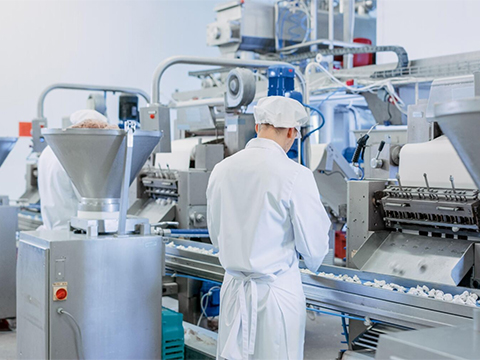
Posted to News on 7th Apr 2025, 09:30
Striking the food safety standardisation balance
Although variety they say is the spice of life, in food safety environments, standards, by definition, usually benefit from the installation of standardised equipment. Commercial Manager Jodie Curry at Fortress Technology Europe explores how this alignment of processes and technology tools can contribute to a safer global food supply chain.

Food is a multinational business asserts the Food Standard Agency (FSA). With global food trade growing by 350% between 2000 and 2021 and reaching a total value of $1.7 trillion , strengthening and harmonising food safety standards has never been more important to facilitate safe trade and protect consumers.
When the world became more globalised in the second half of the 20th century, the network of global food and agricultural trade became denser. More countries began trading with one another, with greater participation from low and middle-income countries. In order to adapt to growing food demand, many manufacturers had to refine their food production practices.
Standardising standards
The World Health Organisation (WHO) considers sufficient access to safe, nutritious food a basic human right. While food globalisation can help improve this access, especially for those who are facing hunger or are food insecure, it also presents many opportunities for harmful food production and handling practices to go unchecked. Jodie Curry comments: "Internationally recognised certifications, and global food safety standards that all food manufacturers must adhere to are crucial to achieving food security for all."
The Codex Alimentarius Commission, an international food standards body established by the Food and Agriculture Organisation (FAO) and the World Health Organisation (WHO), is at the forefront of developing harmonised international food safety standards, guidelines and codes of practice. Additionally, the International Organisation for Standardisation (ISO) develop standards like ISO 22000 as a key framework for food safety management systems.
Working alongside these organisations, the Global Food Safety Initiative (GFSI) benchmarks different food safety certification bodies like SQF, BRCGS, and IFS, to ensure they meet specific criteria for international trade. Compliance with these standards, along with region-specific regulations, is often a prerequisite to accessing global markets.
Standardisation for multi-site manufacturers
Governing bodies and food safety organisations highlight the importance of standardising food safety practices. However, the high cost of compliance, lack of technical expertise and evolving food safety risks, pose ongoing challenges to food manufacturers. International collaboration and support throughout the entire food supply chain are vital to addressing these issues.
For multinational food companies, global standardisation of production processes ensures all locations perform similarly, creating consistency between different countries and regions. This unified approach is important to establishing efficient operations and quality assurance, while simultaneously ensuring full compliance with global food safety standards.
Manufacturing standardisation strategies can include:
- Ensuring all facilities adhere to the same Good Manufacturing Practices (GMPs).
- Implementing the same brand of food inspection equipment and technology across all manufacturing sites to ensure every branch has the same tools and capabilities.
- Purchasing standardised, modular food inspection equipment, built using the same or similar components.
- OPC-UA communication platforms that allow processors to connect equipment and generate a more complete overview of production.
- Utilising the same data collection and reporting software to establish collaborative and valuable datasets.
- Sharing training programmes to ensure staff across all sites are utilising machine functionalities in the same way - maximising productivity and reducing inefficiencies caused by human error.
A multi-site connectivity solution
Food manufacturers that choose to standardise their processes can experience multiple, long-term benefits, such as:
Increased operational efficiency: Research indicates that the average company loses more than 20% of its productive capacity - more than a day each week - to inefficient structures and processes that consume valuable time. Employees generally feel empowered to be productive through the right processes and tools that help reduce overwhelm and stress. With a single set of standards to adhere to, every employee across all manufacturing sites operates with the same information and procedures, ensuring product consistency and eliminating miscommunications and poor task management.
Consistent product quality: With a standardised approach, every product is inspected to meet the same quality standards, regardless of production location. This helps to eliminate issues with regional variability, creates an internal method of quality control and boosts customer satisfaction and trust.
Regulatory compliance: Standardisation across all manufacturing sites ensures full compliance with global food safety standards, avoiding costly legal ramifications and reducing the likelihood of potentially brand-damaging recalls.
Greater ease-of-operation: When utilising the same food inspection equipment manufacturer across multiple sites, there is greater familiarisation of the technology. Rather than being trained to operate multiple different brands of equipment, each with their own specific processes, operators can undergo cohesive training for one, synergetic, standardised technology. This can lead to better ease-of-use and increased productivity.
Interoperability of equipment, technology and processes, reducing administrative burdens. Equipment that meets global standards can also help address rising overhead costs through operational simplicity.
Reduced production costs: Process optimisation and streamlining of operations plays a crucial role in minimising resource consumption and reducing waste. Standardisation helps to identify and resolve bottlenecks or other inefficiencies in production, resulting in better utilisation of materials, energy, labour, and other resources.
Valuable datasets: When a single food factory is interconnected using smart technology that allows for cross-platform communication, the data gathered can hold significant value for a food manufacturer. Imagine how valuable this data could be if it was gathered across multiple sites? Implementing standardised data collection across multiple facilities makes it easier to identify and address areas of improvement, better anticipation food safety incidences, respond quicker to customer concerns and promotes data accuracy and consistency.
"Standardisation in manufacturing almost always delivers positive results and is an important pillar in effective food production. It ensures that every product is of the same quality, and production has a consistent level of efficiency, regardless of who is performing the task. There is simplicity in standardisation: implementing the same technology across multiple sites and streamlining the way your organisation operates can lead to significant productivity and operational gains," Jodie concludes.
Fortress Technology (Europe) Ltd
The Phantom Building
7 Beaumont Road
OX16 1RH
UNITED KINGDOM
+44 (0)1295 256266






